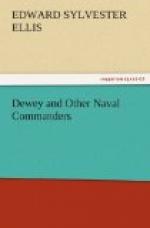At the little town of Erie, Perry began the construction of his fleet, and pushed it with such vigor, in the face of every sort of obstacle, that early in July, 1813, he had ten vessels ready for sea, but only enough men to man one of them. The end of the month made the total three hundred, but he determined to get to sea on the first opportunity. Outside was a powerful blockading squadron, and the water in the lake was so low that it was not until the 4th of August that he was able to get all his vessels over the bar. They comprised the Scorpion, Ariel, Lawrence (flagship), Caledonia, Niagara, Somers, Porcupine, Tigress and Trippe. The total guns carried were 54, with a force of 490 men.
The British squadron consisted of six vessels, with an aggregate of 63 guns and 502 men. They were under the command of Commander Robert H. Barclay, who had fought under Nelson at Trafalgar, and in another battle lost an arm. It was less than three months before that the dying Lawrence had uttered the appeal, “Don’t give up the ship!” and Perry hoisted a flag with the words displayed in large letters. As it floated in the breeze from his vessel it was received with enthusiastic cheers.
It was on the 10th of September, 1814, that the two squadrons met at the western end of Lake Erie. When a mile apart, the Detroit, the British flagship, fired a shot to test the distance. It ricochetted past the Lawrence. A few minutes later she fired a second shot, which smashed into the starboard bulwarks of the Lawrence and sent a cloud of splinters flying. The reply to these was a 32-pounder from the Scorpion. Then the firing became more rapid, the enemy possessing the advantage at long range.
Most of the shots from the British vessels were directed against Perry’s flagship, which suffered considerably. He therefore made sail to get to close quarters. His ship and the Scorpion and Ariel drew considerably ahead of the rest of the fleet. As a consequence they received the main fire of the enemy, which soon became concentrated on the Lawrence, that was gallantly fighting against overwhelming odds. Moreover, she was at a hopeless disadvantage with her short guns, and soon became a wreck, with a large number of her men killed or wounded.
Gradually the boats drifted nearer and the Americans were able to make use of their short guns and small arms. Perry’s clothing was torn by splinters and two musket balls passed through his hat. The battle continued for more than two hours with the utmost desperation, during which the scenes on the Lawrence were too frightful to be described. Finally the wrecked flagship began drifting helplessly out of action, when Perry determined to transfer his flag to the Niagara.
[Illustration: COMMODORE PERRY AT THE BATTLE OF LAKE ERIE.]




